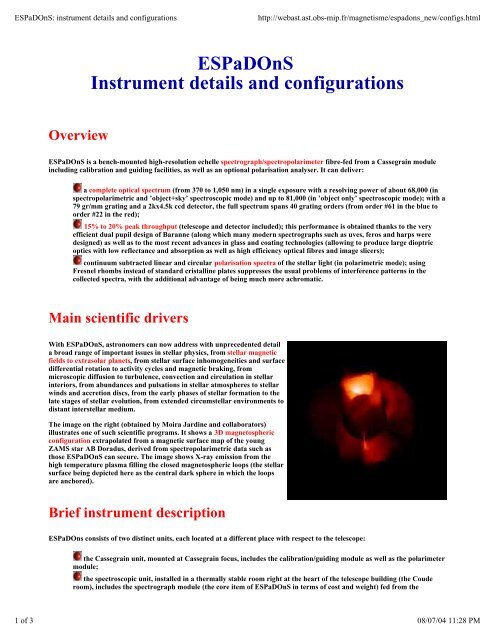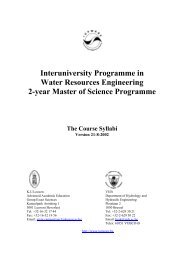CFHT operating manual - Homepage Usask
CFHT operating manual - Homepage Usask
CFHT operating manual - Homepage Usask
Create successful ePaper yourself
Turn your PDF publications into a flip-book with our unique Google optimized e-Paper software.
ESPaDOnS: instrument details and configurations http://webast.ast.obs-mip.fr/magnetisme/espadons_new/configs.html<br />
Overview<br />
ESPaDOnS<br />
Instrument details and configurations<br />
ESPaDOnS is a bench-mounted high-resolution echelle spectrograph/spectropolarimeter fibre-fed from a Cassegrain module<br />
including calibration and guiding facilities, as well as an optional polarisation analyser. It can deliver:<br />
a complete optical spectrum (from 370 to 1,050 nm) in a single exposure with a resolving power of about 68,000 (in<br />
spectropolarimetric and ’object+sky’ spectroscopic mode) and up to 81,000 (in ’object only’ spectroscopic mode); with a<br />
79 gr/mm grating and a 2kx4.5k ccd detector, the full spectrum spans 40 grating orders (from order #61 in the blue to<br />
order #22 in the red);<br />
15% to 20% peak throughput (telescope and detector included); this performance is obtained thanks to the very<br />
efficient dual pupil design of Baranne (along which many modern spectrographs such as uves, feros and harps were<br />
designed) as well as to the most recent advances in glass and coating technologies (allowing to produce large dioptric<br />
optics with low reflectance and absorption as well as high efficiency optical fibres and image slicers);<br />
continuum subtracted linear and circular polarisation spectra of the stellar light (in polarimetric mode); using<br />
Fresnel rhombs instead of standard cristalline plates suppresses the usual problems of interference patterns in the<br />
collected spectra, with the additional advantage of being much more achromatic.<br />
Main scientific drivers<br />
With ESPaDOnS, astronomers can now address with unprecedented detail<br />
a broad range of important issues in stellar physics, from stellar magnetic<br />
fields to extrasolar planets, from stellar surface inhomogeneities and surface<br />
differential rotation to activity cycles and magnetic braking, from<br />
microscopic diffusion to turbulence, convection and circulation in stellar<br />
interiors, from abundances and pulsations in stellar atmospheres to stellar<br />
winds and accretion discs, from the early phases of stellar formation to the<br />
late stages of stellar evolution, from extended circumstellar environments to<br />
distant interstellar medium.<br />
The image on the right (obtained by Moira Jardine and collaborators)<br />
illustrates one of such scientific programs. It shows a 3D magnetospheric<br />
configuration extrapolated from a magnetic surface map of the young<br />
ZAMS star AB Doradus, derived from spectropolarimetric data such as<br />
those ESPaDOnS can secure. The image shows X-ray emission from the<br />
high temperature plasma filling the closed magnetospheric loops (the stellar<br />
surface being depicted here as the central dark sphere in which the loops<br />
are anchored).<br />
Brief instrument description<br />
ESPaDOns consists of two distinct units, each located at a different place with respect to the telescope:<br />
the Cassegrain unit, mounted at Cassegrain focus, includes the calibration/guiding module as well as the polarimeter<br />
module;<br />
the spectroscopic unit, installed in a thermally stable room right at the heart of the telescope building (the Coude<br />
room), includes the spectrograph module (the core item of ESPaDOnS in terms of cost and weight) fed from the<br />
1 of 3 08/07/04 11:28 PM

















